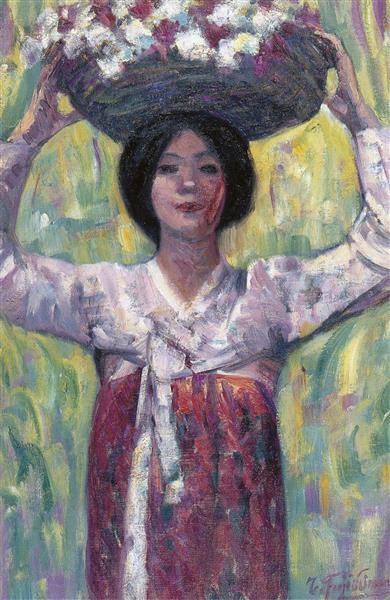Description
The work "Cesta de Flores" (Flower Basket) by Fujishima Takeji is a shining example of the fusion between Japanese tradition and Western aesthetics that characterizes much of the Nihonga movement in the early 20th century. This painting, which is part of the collection of the National Museum of Modern Art in Tokyo, offers us a profound exploration of the natural beauty and serenity that can be found in the representation of flowers.
In the composition, the basket is the focal point, skillfully placed in the center of the canvas, instantly attracting the viewer's attention. It is a simple object made of cane, suggesting domestic functionality, but it also presents an aura of elegance that takes the work beyond the mere representation of an everyday element. The flowers emerging from the basket are vibrant and diverse; roses, lilies, and other species, created with a technical mastery that highlights Fujishima's skill. The petals are represented with subtlety, each capturing light differently, giving a sense of life and freshness to the composition.
The use of color in "Cesta de Flores" is one of the most captivating aspects of the work. The palette is rich and varied, with tones ranging from soft pastels to vibrant reds and yellows, creating a visual contrast that energizes the piece. Fujishima's ability to blend natural colors with an almost photographic clarity reflects the influence of Impressionism while maintaining a traditional Japanese essence. This balance between light and shadow, as well as transparency and opacity, highlights his painting technique, revealing the influences of his training both in Japan and in Europe.
Fujishima Takeji, born in 1866, was an important exponent of the Nihonga movement, but he was also influenced by Impressionism and Western art. His training at the Tokyo Academy of Fine Arts and his subsequent trip to France enriched his understanding of color and form. "Cesta de Flores" encapsulates this duality in its style, where traditional Japanese elements amalgamate with Western techniques. The work can be seen not only as a simple flower painting but as a dialogue between cultures, a tribute to the natural aesthetics that transcend borders.
In the context of similar works by Fujishima and other artists of his time, "Cesta de Flores" can be compared to Japanese ceramics and textiles that also address floral themes with a similar focus on aesthetics and symbolism. Nature in traditional Japanese art has been a recurring theme that invites contemplation on life and death, ephemeral beauty, and cultural customs. Thus, the painting is not only an object of visual admiration but also an invitation to reflect on the intimate connection between human beings and nature.
In conclusion, "Cesta de Flores" by Fujishima Takeji is a work that transcends its time, offering a visual experience rich in textures and colors that invite the viewer to reflect on the beauty of the everyday. His skillful technique and deep understanding of floral symbolism within a hybrid cultural framework not only celebrate but preserve the essence of the Japanese aesthetic experience, making this work an important reference in the history of modern art in Japan.
KUADROS ©, a famous painting on your wall.
Hand-made oil painting reproductions, with the quality of professional artists and the distinctive seal of KUADROS ©.
Reproduction service of paintings with a satisfaction guarantee. If you are not completely satisfied with the replica of your painting, we will refund 100% of your money.

